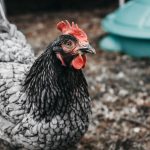Chickens are social creatures with innate instincts to explore and forage. They exhibit curiosity but can be easily startled by sudden movements or loud noises. Understanding these behavioral traits is essential for effectively containing chickens within a designated area.
By recognizing their natural tendencies, caretakers can anticipate potential issues and implement appropriate preventive measures to deter fence-jumping. The social hierarchy, or pecking order, within a flock is another important aspect of chicken behavior. Identifying dominant individuals can help predict which birds may be more likely to attempt escape.
This knowledge allows for targeted interventions and management strategies. Chickens thrive on routine and structure. Establishing a consistent feeding schedule and ensuring constant access to fresh water can contribute to their contentment and reduce the likelihood of escape attempts.
Providing ample space for roaming and exploration within their designated area can satisfy their natural instincts, further decreasing the urge to fly over fences. By comprehensively understanding chicken behavior, caretakers can create a secure and comfortable environment that addresses the birds’ needs and minimizes the risk of escape attempts. This approach promotes the overall well-being of the flock while maintaining effective containment.
Table of Contents
- 1 Assessing the height and design of the fence
- 2 Implementing deterrents to prevent flying
- 3 Providing alternative forms of entertainment and stimulation
- 4 Monitoring and adjusting the flock’s behavior
- 5 Seeking professional advice and assistance
- 6 Recognizing the benefits of free-range chickens
- 7 FAQs
- 7.1 Why do chickens keep flying over the fence?
- 7.2 How high can chickens fly?
- 7.3 What can be done to prevent chickens from flying over the fence?
- 7.4 Are there any specific breeds of chickens that are less likely to fly over the fence?
- 7.5 Can clipping a chicken’s wings prevent them from flying over the fence?
Key Takeaways
- Chickens have natural behaviors such as flying, scratching, and perching that need to be understood and accommodated.
- The height and design of the fence should be carefully assessed to prevent chickens from flying over and escaping.
- Implementing deterrents such as netting, wing clipping, or installing obstacles can help prevent chickens from flying over the fence.
- Providing alternative forms of entertainment and stimulation, such as perches, toys, and foraging areas, can help reduce the desire to fly.
- Regularly monitoring and adjusting the flock’s behavior can help identify any issues and make necessary changes to prevent flying.
- Seeking professional advice and assistance from poultry experts can provide valuable insights and solutions for preventing flying.
- Recognize the benefits of free-range chickens, such as improved welfare and natural behaviors, while also taking steps to prevent flying and ensure their safety.
Assessing the height and design of the fence
Fence Height: A Critical Factor
Assessing the height of the fence is crucial, as it will help determine whether it needs to be raised to effectively contain the chickens within their designated area.
Fence Design: A Key Consideration
The design of the fence is equally important, as it should be sturdy and secure to prevent any potential escape attempts. By assessing the height and design of the fence, you can identify any potential weak points that may need reinforcement to effectively contain the chickens.
Assessing the Surrounding Area
In addition to the height and design of the fence, it’s important to consider any potential obstacles or structures near the fence that could aid in the chickens’ escape. Trees, shrubs, or other structures near the fence could provide a launching point for chickens attempting to fly over it. Assessing the surrounding area and removing any potential aids for escape can help further secure the designated area and prevent chickens from attempting to fly over the fence.
Implementing deterrents to prevent flying

Implementing deterrents can be an effective way to prevent chickens from attempting to fly over the fence. One common deterrent is to clip their flight feathers, which can limit their ability to fly long distances. This practice is painless for the chickens and can be an effective way to prevent them from escaping their designated area.
Another deterrent is to install netting or wire mesh over the top of the fenced area to prevent any potential escape attempts. This additional barrier can help further secure the area and prevent chickens from attempting to fly over the fence. Another effective deterrent is to provide plenty of distractions within their designated area to keep them occupied and less likely to attempt to escape.
This can include providing toys, perches, or other forms of entertainment that can help keep them engaged and satisfied within their designated space. By implementing deterrents such as clipping flight feathers, installing netting or wire mesh, and providing distractions within their designated area, you can effectively prevent chickens from attempting to fly over the fence.
Providing alternative forms of entertainment and stimulation
In addition to implementing deterrents, providing alternative forms of entertainment and stimulation within their designated area can help keep chickens content and less likely to attempt to escape. Chickens are naturally curious animals that thrive on exploration and foraging for food. Providing them with plenty of space to roam and explore, as well as access to fresh grass and insects, can help satisfy their natural instincts and reduce the urge to fly over the fence.
Additionally, providing them with toys, perches, or other forms of entertainment can help keep them engaged and less likely to attempt an escape. Another way to provide stimulation for chickens is by introducing new elements into their environment on a regular basis. This can include rotating their grazing area or introducing new objects for them to investigate.
By providing variety and novelty within their designated area, you can help keep them engaged and less likely to attempt an escape. Providing alternative forms of entertainment and stimulation within their designated area is essential for keeping chickens content and reducing the likelihood of them trying to fly over the fence.
Monitoring and adjusting the flock’s behavior
Monitoring the flock’s behavior is essential for identifying any potential escape attempts and taking proactive measures to prevent them. By observing their behavior on a regular basis, you can identify any potential troublemakers who may be more likely to attempt an escape. Additionally, monitoring their behavior can help you identify any potential weaknesses in the fencing or surrounding area that may need reinforcement.
By staying vigilant and monitoring the flock’s behavior, you can take proactive measures to prevent them from attempting to fly over the fence. In addition to monitoring their behavior, it’s important to adjust their environment as needed to keep them content and less likely to attempt an escape. This can include providing new forms of entertainment or stimulation, as well as making any necessary adjustments to the fencing or surrounding area.
By monitoring and adjusting the flock’s behavior, you can create a secure and comfortable environment for them, ultimately reducing the likelihood of them trying to fly over the fence.
Seeking professional advice and assistance

When chickens continue to escape despite your best efforts, it may be time to seek professional help.
Expert Insights from Animal Behaviorists and Veterinarians
A professional animal behaviorist or veterinarian with experience in poultry can provide valuable insights into understanding your chickens’ behavior and offer effective solutions for preventing them from escaping. They can assess your current setup and provide recommendations for adjustments that may help contain your flock more effectively.
Learning from Experienced Poultry Farmers and Chicken Owners
Additionally, seeking assistance from experienced poultry farmers or other chicken owners can provide valuable insights into effective strategies for preventing chickens from flying over fences. They may have encountered similar challenges with their own flocks and can offer practical advice based on their experiences.
Gaining Valuable Knowledge and Support
By seeking professional advice and assistance, you can gain valuable knowledge and support in effectively containing your chickens within their designated area.
Recognizing the benefits of free-range chickens
While preventing chickens from flying over fences is important for their safety and containment, it’s also important to recognize the benefits of allowing chickens some freedom within a designated free-range area. Free-range chickens have access to fresh grass, insects, and other natural elements that contribute to their overall well-being. They also have more space to roam and explore, which can help satisfy their natural instincts and reduce stress levels.
In addition, free-range chickens often exhibit more natural behaviors such as dust bathing, sunbathing, and socializing with other members of their flock. Allowing chickens some freedom within a designated free-range area can contribute to their overall happiness and well-being. While it’s important to prevent them from flying over fences for safety reasons, recognizing the benefits of free-range chickens can help inform your approach in creating a secure yet enriching environment for your flock.
In conclusion, understanding the behavior of chickens is essential for creating a secure environment that prevents them from attempting to fly over fences. Assessing the height and design of the fence, implementing deterrents, providing alternative forms of entertainment and stimulation, monitoring and adjusting the flock’s behavior, seeking professional advice and assistance, and recognizing the benefits of free-range chickens are all important considerations in effectively containing chickens within a designated area. By taking proactive measures based on these considerations, you can create a safe and enriching environment for your flock while preventing them from attempting to escape over fences.
If you’re having trouble with chickens flying over the fence, you may want to consider building an A-frame chicken coop to keep them contained. This type of coop is designed to prevent chickens from escaping and can be a great solution for keeping your flock safe and secure. Check out this article on A-Frame Chicken Coop for more information on how to build and use this type of coop.
FAQs
Why do chickens keep flying over the fence?
Chickens are natural flyers and have the ability to fly short distances. They may fly over the fence in search of food, to escape predators, or simply out of curiosity.
How high can chickens fly?
Chickens can typically fly up to 10 feet in the air, although this can vary depending on the breed and individual chicken.
What can be done to prevent chickens from flying over the fence?
To prevent chickens from flying over the fence, the fence can be made higher or covered with netting to prevent them from gaining enough height to fly over. Additionally, trimming their flight feathers can limit their ability to fly.
Are there any specific breeds of chickens that are less likely to fly over the fence?
Some breeds of chickens, such as heavier breeds like Orpingtons or Brahmas, are less likely to fly over fences due to their larger size and heavier build.
Can clipping a chicken’s wings prevent them from flying over the fence?
Yes, clipping a chicken’s wings can prevent them from flying over the fence. This involves trimming the primary flight feathers on one wing, which limits their ability to achieve lift and fly long distances.

Meet Walter, the feathered-friend fanatic of Florida! Nestled in the sunshine state, Walter struts through life with his feathered companions, clucking his way to happiness. With a coop that’s fancier than a five-star hotel, he’s the Don Juan of the chicken world. When he’s not teaching his hens to do the cha-cha, you’ll find him in a heated debate with his prized rooster, Sir Clucks-a-Lot. Walter’s poultry passion is no yolk; he’s the sunny-side-up guy you never knew you needed in your flock of friends!
Meet Walter, the feathered-friend fanatic of Florida! Nestled in the sunshine state, Walter struts through life with his feathered companions, clucking his way to happiness. With a coop that’s fancier than a five-star hotel, he’s the Don Juan of the chicken world. When he’s not teaching his hens to do the cha-cha, you’ll find him in a heated debate with his prized rooster, Sir Clucks-a-Lot. Walter’s poultry passion is no yolk; he’s the sunny-side-up guy you never knew you needed in your flock of friends!







